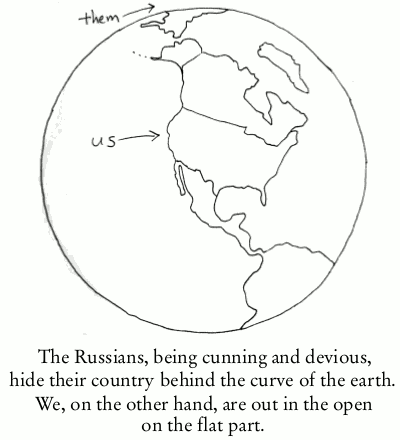April 2014 archive
Time and space are different and it's not shocking that people
have different feelings about them. I see some people wish for
eternal life but never that their bodies swell to occupy all of space.
Time and space have different qualities, and yet one of the cooler lessons of 20th century physics is that the two are inseparable. The implications of that finding can take a while to sink in.
I submit that the inseparability of time and space poses a logical problem to typical notions of life after death. Various traditions teach that one's earthly point of view is followed by some other form untethered to space as we know it. Heaven and hell have no latitude and longitude, nor do the bardo states that some traditions say await us in between incarnations. The words I've italicized refer to temporal succession. They are rooted in time.
Spatially indistinct consciousness after death strikes me as inconsistent with an appreciation of the interdependence of space and time. It takes a naïve, pre-Einsteinian worldview to imagine partaking of time but not of space.
I don't present this as an airtight argument, just one (among many) that I think deserves consideration. Shortly after John Paul II took office, I heard a dude in a record store in Manhattan say, that's two popes named after Lennon and McCartney.
Given the prominence news media have accorded today's events, you have probably heard that JPII was recognized as a saint, having posthumously worked two miracles to the Church's satisfaction—which says more about Church operatives who vet miracles than it does about the ability of the deceased. I'm reminded of when I was applying for a mortgage in 1997 and wondered whether the house would appraise at a sufficient value. "Relax," a friend said. "The bank has ordered an appraisal."
The Catholic Church used to appoint a devil's advocate to argue the case against proposed saints, but JPII abolished that practice in 1983 (and the pace of canonizations picked up markedly). Sometimes the Church informally invites critics to testify. In arguing against Mother Teresa, Christopher Hitchens said he "drew the job of representing the Evil One, as it were, pro bono."
Why bother remarking about a canonization? Because media complicity rankles. I'll quote Christopher Hitchens again because I miss him:
Before the advent of the Internet, going to bars was one of the better
ways to meet gay people. But when I reached drinking age (18 in New
York at the time) I didn't like alcohol and pretty much every bar
played disco. I didn't go to bars until I discovered one
that I had fun at: it played rock and roll and it had a pool table.
I like playing pool, and this place had good players that I learned stuff from. One guy made shots I've never been able to duplicate. He ultimately got thrown out of the bar for playing too well. Well, also for being unfriendly—but it was his beating everyone at pool that was the last straw. Or maybe he wasn't buying any drinks.
As bar pool table protocol lets you play as long as you keep winning (at least if you're gracious about it), and as playing pool is one of few things I can enjoy doing in a bar, I had incentive to improve my game. From 1981‑82 I lived in an apartment complex with pool tables and I learned a bit just by experimenting. I discovered that some complicated shots were not as hard as they looked. I never got to be a great player but I had a lot of fun.
I don't think Confucius had billiards in mind, but he was right when he said (Analects, 1.1.1): (thanks Sasha for finding this)
When taking pics of the sun or moon near the horizon,
it helps to know how much time it takes for objects to rise or set.
If you can remember that the apparent diameter of
the moon or sun is about ½ of a degree of arc,
calculating the rate they set at is easy.
(thanks Sasha for finding this)
When taking pics of the sun or moon near the horizon,
it helps to know how much time it takes for objects to rise or set.
If you can remember that the apparent diameter of
the moon or sun is about ½ of a degree of arc,
calculating the rate they set at is easy.
A day is a turn of 360 degrees. Rising-setting motion is 360 ÷ ½ = 720 moon‑or‑sun diameters in a day, or 30 diameters in an hour. So the moon or sun takes roughly two minutes to rise or set the distance of its own diameter.
Roughly. The moon's orbital motion makes it set about 3% more slowly than the sun does, if that matters.
And speaking of orbital motion, sometimes the moon will be approaching a star or planet and I'll want to estimate when it'll be in the spot I want for a pic. If you can remember how many days are in a month, that's about how much slower the moon's motion relative to the stars is than its rising-setting motion. The moon orbits in somewhat less than 30 days so it takes a little less than 30 × 2 minutes = one hour to move a distance of its own diameter.
Last night's eclipse reminded me of all this. The total phase of a lunar eclipse begins a little less than an hour after the start of the umbral phase.
From reviews of paintings by our last President:
My friend knew how ubiquitous π is, not just in geometry/trig but in every branch of mathematics. He just liked to ask questions that made you consider anything you might be overlooking.
Funny thing is, that conversation didn't lead to what I now see as the elephant in the room—namely that it's better to have a symbol for the ratio of a circle's circumference to its radius rather than its diameter. The appearance of 2π in so many formulas in math and physics (e.g., angular frequency is 2πf ) is a hint that 2π is more fundamental. The case for 2π is laid out in detail in Michael Hartl's The Tau Manifesto, whose arguments I find compelling. Were I designing math nomenclature from scratch, I would so define a symbol for 6.28318... instead of 3.14159... .
Will the world see the light? The weight of literature and tradition behind our definition of π is huge. We're stuck with it like we're stuck with the QWERTY keyboard. As much as I'd like to see the movement to ditch π in favor of τ (=2π) succeed, I think it's a longshot to get much traction in my lifetime. But I'd bet you a nickel that if we ever compare notes with extraterrestrials, they'll have a symbol for τ instead of π.
Time and space have different qualities, and yet one of the cooler lessons of 20th century physics is that the two are inseparable. The implications of that finding can take a while to sink in.
I submit that the inseparability of time and space poses a logical problem to typical notions of life after death. Various traditions teach that one's earthly point of view is followed by some other form untethered to space as we know it. Heaven and hell have no latitude and longitude, nor do the bardo states that some traditions say await us in between incarnations. The words I've italicized refer to temporal succession. They are rooted in time.
Spatially indistinct consciousness after death strikes me as inconsistent with an appreciation of the interdependence of space and time. It takes a naïve, pre-Einsteinian worldview to imagine partaking of time but not of space.
I don't present this as an airtight argument, just one (among many) that I think deserves consideration. Shortly after John Paul II took office, I heard a dude in a record store in Manhattan say, that's two popes named after Lennon and McCartney.
Given the prominence news media have accorded today's events, you have probably heard that JPII was recognized as a saint, having posthumously worked two miracles to the Church's satisfaction—which says more about Church operatives who vet miracles than it does about the ability of the deceased. I'm reminded of when I was applying for a mortgage in 1997 and wondered whether the house would appraise at a sufficient value. "Relax," a friend said. "The bank has ordered an appraisal."
The Catholic Church used to appoint a devil's advocate to argue the case against proposed saints, but JPII abolished that practice in 1983 (and the pace of canonizations picked up markedly). Sometimes the Church informally invites critics to testify. In arguing against Mother Teresa, Christopher Hitchens said he "drew the job of representing the Evil One, as it were, pro bono."
Why bother remarking about a canonization? Because media complicity rankles. I'll quote Christopher Hitchens again because I miss him:
I am not a Catholic. Its rituals and observances are less than nothing to me. I object only when the mass media report a propaganda event as if it were to be taken at its own face value.I didn't always agree with Hitchens but he said a lot of things that needed to be said.
|
where "wind" means "horizontal component of wind",
and where "points" means "at least two points" -- Wind never blows everywhere on the earth's surface. There are always points of calm. |  |
I like playing pool, and this place had good players that I learned stuff from. One guy made shots I've never been able to duplicate. He ultimately got thrown out of the bar for playing too well. Well, also for being unfriendly—but it was his beating everyone at pool that was the last straw. Or maybe he wasn't buying any drinks.
As bar pool table protocol lets you play as long as you keep winning (at least if you're gracious about it), and as playing pool is one of few things I can enjoy doing in a bar, I had incentive to improve my game. From 1981‑82 I lived in an apartment complex with pool tables and I learned a bit just by experimenting. I discovered that some complicated shots were not as hard as they looked. I never got to be a great player but I had a lot of fun.
I don't think Confucius had billiards in mind, but he was right when he said (Analects, 1.1.1):
To study, and when the occasion arises to put what one has learned into practice—is that not deeply satisfying?
From the NY Times web site this afternoon.
It was reworded after about 90 minutes.
 (thanks Sasha for finding this)
When taking pics of the sun or moon near the horizon,
it helps to know how much time it takes for objects to rise or set.
If you can remember that the apparent diameter of
the moon or sun is about ½ of a degree of arc,
calculating the rate they set at is easy.
(thanks Sasha for finding this)
When taking pics of the sun or moon near the horizon,
it helps to know how much time it takes for objects to rise or set.
If you can remember that the apparent diameter of
the moon or sun is about ½ of a degree of arc,
calculating the rate they set at is easy.
A day is a turn of 360 degrees. Rising-setting motion is 360 ÷ ½ = 720 moon‑or‑sun diameters in a day, or 30 diameters in an hour. So the moon or sun takes roughly two minutes to rise or set the distance of its own diameter.
Roughly. The moon's orbital motion makes it set about 3% more slowly than the sun does, if that matters.
And speaking of orbital motion, sometimes the moon will be approaching a star or planet and I'll want to estimate when it'll be in the spot I want for a pic. If you can remember how many days are in a month, that's about how much slower the moon's motion relative to the stars is than its rising-setting motion. The moon orbits in somewhat less than 30 days so it takes a little less than 30 × 2 minutes = one hour to move a distance of its own diameter.
Last night's eclipse reminded me of all this. The total phase of a lunar eclipse begins a little less than an hour after the start of the umbral phase.
|
Illustration from
US Patent 5023850,
"Clock for keeping time at a rate other than human time".
The clock could run at 7x in a canine application, thereby
reminding humans of "the value to the animal of the duration"
of activities. So if time is money,
a day is seven times as expensive if you're a dog.
I've wondered how hummingbirds perceive time. We move in slow motion by comparison. |  |
Mr. Bush has an uncanny ability to translate photographs into more awkward images enlivened by distortions and slightly ham-handed brushwork.
These empty headed daubs look the work of someone you wouldn't trust to mow a lawn without cutting someone's foot off.(NY Times and The Guardian, respectively) Assuming that
there are intelligent extraterrestrials,
and
they write (with symbols on two-dimensional surfaces),
I once said I'd be curious to see what symbol an alien culture used for
π, and a friend asked,
"How do you know they would have a π in their mathematics?"
they write (with symbols on two-dimensional surfaces),
My friend knew how ubiquitous π is, not just in geometry/trig but in every branch of mathematics. He just liked to ask questions that made you consider anything you might be overlooking.
Funny thing is, that conversation didn't lead to what I now see as the elephant in the room—namely that it's better to have a symbol for the ratio of a circle's circumference to its radius rather than its diameter. The appearance of 2π in so many formulas in math and physics (e.g., angular frequency is 2πf ) is a hint that 2π is more fundamental. The case for 2π is laid out in detail in Michael Hartl's The Tau Manifesto, whose arguments I find compelling. Were I designing math nomenclature from scratch, I would so define a symbol for 6.28318... instead of 3.14159... .
Will the world see the light? The weight of literature and tradition behind our definition of π is huge. We're stuck with it like we're stuck with the QWERTY keyboard. As much as I'd like to see the movement to ditch π in favor of τ (=2π) succeed, I think it's a longshot to get much traction in my lifetime. But I'd bet you a nickel that if we ever compare notes with extraterrestrials, they'll have a symbol for τ instead of π.

(recreation of a cartoon
I saw years ago,
maybe in Harper's but I'm not sure)
maybe in Harper's but I'm not sure)